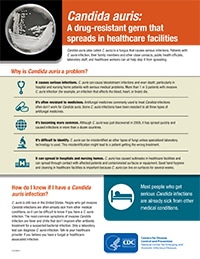Fact Sheet
Candida auris: A Drug-resistant Germ That Spreads in Healthcare Facilities

Candida auris (also called C. auris) is a fungus that causes serious infections. Patients with C. aurisinfection, their family members and other close contacts, public health officials, laboratory staff, and healthcare workers can all help stop it from spreading.
Why is Candida auris a problem?
- It causes serious infections. C. auris can cause bloodstream infections and even death, particularly in hospital and nursing home patients with serious medical problems. More than 1 in 3 patients with invasive C. auris infection (for example, an infection that affects the blood, heart, or brain) die.
- It’s often resistant to medicines. Antifungal medicines commonly used to treat Candida infections often don’t work for Candida auris. Some C. auris infections have been resistant to all three types of antifungal medicines.
- It’s becoming more common. Although C. auris was just discovered in 2009, it has spread quickly and caused infections in more than a dozen countries.
- It’s difficult to identify. C. auris can be misidentified as other types of fungi unless specialized laboratory technology is used. This misidentification might lead to a patient getting the wrong treatment.
- It can spread in hospitals and nursing homes. C. auris has caused outbreaks in healthcare facilities and can spread through contact with affected patients and contaminated surfaces or equipment. Good hand hygiene and cleaning in healthcare facilities is important because C. auris can live on surfaces for several weeks.
How do I know if I have a Candida auris infection?
C. auris is still rare in the United States. People who get invasive Candida infections are often already sick from other medical conditions, so it can be difficult to know if you have a C. auris infection. The most common symptoms of invasive Candida infection are fever and chills that don’t improve after antibiotic treatment for a suspected bacterial infection. Only a laboratory test can diagnose C. auris infection. Talk to your healthcare provider if you believe you have a fungal or healthcare-associated infection.
Stopping the spread of Candida auris
CDC is working with public health partners, healthcare workers, and laboratories to stop the spread of C. auris in healthcare settings. Here’s how CDC is asking everyone to help:
- Family members and other close contacts of patients with C. auris
- Clean your hands with hand sanitizer or soap and water before and after touching a patient with C. auris or equipment in his or her room.
- Remind healthcare workers to clean their hands.
- Laboratory staff, healthcare workers, and public health officials
- Know when to suspect C. auris and how to properly identify it.
- Report cases quickly to public health departments.
- For healthcare workers, clean hands correctly and use precautions like wearing gowns and gloves to prevent spread.
- Clean patient rooms thoroughly with a disinfectant that works against C. auris.
- Investigate C. auris cases quickly and determine additional ways to prevent spread.
- See Recommendations for Identification, Treatment, and Infection control of Candida auris.
Scientists are still learning about Candida auris
CDC and public health partners are working hard to better understand C. auris and answer the following questions so that we can continue to help protect people from this serious infection:
- Why is C. auris resistant to antifungal medicines?
- Why did C. auris start causing infections in recent years?
- Where did C. auris originally come from, and why has it appeared in many regions of the world at the same time?
What is CDC doing?
CDC is collaborating closely with partners to better respond, contain spread, and prevent future infections by:
- Advising healthcare workers and infection control staff on ways to stop the spread of C. auris and continually updating this guidance as we learn more about the infection.
- Working with state and local health agencies, healthcare facilities, and clinical microbiology laboratories to ensure that laboratories are using proper methods to detect C. auris.
- Testing C. auris strains to monitor for resistance to antifungal medicines.
- Examining the DNA of C. auris strains using whole genome sequencing to better understand how this germ is spreading in the United States and around the world.
- Working with public health partners in the United States and internationally to learn more about how C. auris spreads in healthcare facilities and to eliminate it from those facilities.






















.png)











No hay comentarios:
Publicar un comentario